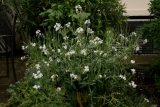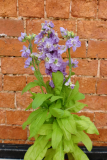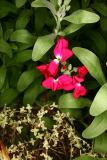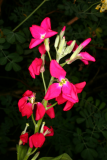Additional notes (click to expand)
Commemorative
Matthiola incana is the Latin name for the summer-flowering garden ‘Ten-week Stocks’. It commemorates Pietro Andrea Mattioli (1500/1–77), physician and botanist, whose name is Latinised to Matthiolus. He was born on 23 March 1500 in the old Gregorian calendar (1501 using the modern system), in Siena, Italy, and died of the plague in Trento. He gained his MD from
Padua in 1523 and practised medicine in Italy and Austria as the physician to Archduke Ferdinand II and to Maximillian II, the holy Roman emperor. The study of plants was a major part of medicine, and Dioscorides’ herbal, his six-part Materia medica from the 1st century AD, was the basis of medicinal practice. Mattioli published an Italian translation of Dioscorides, and in the same year a Latin version, with a commentary, Commentarii in libros sex Pedacii Dioscoridis Anazarbei de medica materia (1554). Like other writers of the time, he identifi ed the plants of Dioscorides but also added in all the plants known to him. The detailed woodcuts of the later editions set a
new standard; the books were incredibly popular and it is reported that 32,000 copies of the early editions were sold. He published other books including a poem on the Palace of the Cardinal of Trento, Il magno Palazzo del Cardinale di Trento (1539), one on the plague, Remedia contra pestem (1564), and on distillation of the sap of plants and preserving their taste and fragrance, Del modo di distillare le acque da tutte le piante ... (1604).
Oakeley, Dr. Henry. (2012). Doctors in the Medicinal Garden. Plants named after physicians. Royal College of Physicians.
link
Horticulture
Originating from sandy and rocky seaside areas of the Mediterranean, Matthiola incana is a fragrant annual or biennial in the Brassicaceae family. It prefers to grow in fertile soil in full sun. Seed should be sown under glass in early spring and planted out after frosts are past, or outdoors in June or July. Young plants are overwintered in an unheated glasshouse or cold frame to flower in summer the following year. It sometimes continues as a short-lived perennial if conditions are favourable. (Clare Beacham)
Oakeley, Dr. Henry. (2012). Doctors in the Medicinal Garden. Plants named after physicians. Royal College of Physicians.
link
Nomenclature
The genus name commemorates Pietro Andrea Mattioli (1500/1–77), physician and botanist, whose name is Latinised to Matthiolus. Incana means hoary or grey, referring to the colour of the leaves.
Oakeley, Dr. Henry. (2012). Doctors in the Medicinal Garden. Plants named after physicians. Royal College of Physicians.
link
Other use
Matthiola incana (L.)W.T.Aiton Brassicaceae Distribution: The genus name commemorates Pietro Andrea Mattioli (1500/1–77), physician and botanist, whose name is Latinised to Matthiolus.. Incana means hoary or grey, referring to the colour of the leaves. Mattioli's commentaries on the Materia Medica of Dioscorides were hugely popular. Matthiola incana was first described by Linnaeus as Cheiranthus incanus, being changed to Matthiola by William Aiton, at Kew, in 1812. It is in the cabbage family. Commercial seed packets contain a mixture of single and double forms. The latter are sterile, but selective breeding has increased the proportion of double forms from the seed of single forms to as much as 80%. ‘Ten week stocks’ are popular garden annuals, flowering in the year of sowing, whereas ‘Brompton stocks’ (another variety of M. incana) are biennials, flowering the following year. Gerard (1633), called them Stocke Gillofloure or Leucoium, and notes the white and purple forms, singles and doubles. About their medicinal value he writes ‘not used in Physicke except among certain Empiricks and Quacksalvers, about love and lust matters, which for modestie I omit’. The thought of a member of the cabbage family being an aphrodisiac might encourage the gullible to take more seriously the government’s plea to eat five portions of vegetable/fruit per day.
Oakeley, Dr. Henry. (2012). Doctors in the Medicinal Garden. Plants named after physicians. Royal College of Physicians.
link
Matthiola incana appears as Viola-matrionalis alba, V. punicea and V. purpurea in Fuchs (1542), as Leucoium purpureum et album in Matthioli (1569) and Lobel (1576), typified by Linnaeus (1753) as Cheiranthus incanus, before being finally re-named Matthiola incana by William Aiton, at Kew, in 1812. They have clearly been in cultivation for at least 500 years in northern Europe. Whether this was the plant known to Dioscorides (AD 70 ) is uncertain, for he described it as white, quince-yellow or purple, and recommends it in baths for uterine disorders and to induce menstruation. The groundup roots applied as a poultice were, he writes, good for the spleen and for gout (Beck, 2005). It may be that the yellow flowers of Dioscorides were those of the not dissimilar wallflower, Erysimum cheiri. Fuchs noted them as garden plants which, soaked in water (presumably hot) whose vapour was then inhaled, would help those with convulsions, breathing diffi culties and chronic cough, stimulate urine and menstruation, and induce sweating.
Oakeley, Dr. Henry. (2012). Doctors in the Medicinal Garden. Plants named after physicians. Royal College of Physicians.
link
Matthiola incana (L.) W.T.Aiton
Family: BRASSICACEAEGenus: Matthiola
Species: incana (L.) W.T.Aiton
Common names: Brompton stock
Distribution summary: Mediterranean
Habit: Biennial
Garden status: Not currently grown
Reason for growing: Commemorative










